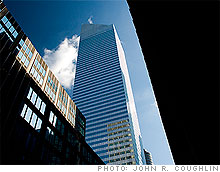Big banks try to extend winning streak
Surge in investment banking, mortgage refinancing activity could again bolster second-quarter results for lenders like Chase, BofA.
 |
| Citigroup may be the lone bank to suffer a loss this quarter, when it delivers its results before Friday's opening bell. |
NEW YORK (CNNMoney.com) -- Will the big banks do it again?
After enduring criticism that their impressive performance in the previous quarter was largely a fluke, all eyes are on financial giants like Goldman Sachs (GS, Fortune 500), Bank of America (BAC, Fortune 500) and Wells Fargo (WFC, Fortune 500) as they begin to report their second-quarter results starting later this week.
"I think you are going to see something quite similar to what we saw in the first quarter," said Martin Kinsler, a London-based fund manager at Henderson Global Investors, which oversees approximately $80 billion in assets.
But not every analyst agrees. While many of the factors that gave top lenders a boost last quarter were still in effect this quarter, big banks were forced to reckon with, among other things, issuing new shares to pay back money from TARP, a special assessment from the FDIC, as well as higher loan losses, all of which has weighed on earnings and muddied expectations.
Right now estimates for the banks vary wildly. JPMorgan Chase, for example, is expected to report anywhere from a profit of 27 cents a share to a loss of 23 cents a share. Bank of America's estimates, on the other hand, range from a loss of 11 cents to a profit of 70 cents a share.
Kicking off the earnings season for financial firms is Goldman Sachs (GS, Fortune 500), which reports before Tuesday's opening bell. The Wall Street firm is expected to have earned $1.7 billion, or $3.54 a share, according to estimates compiled by Thomson Reuters.
The Thomson Reuters consensus for JPMorgan Chase (JPM, Fortune 500) is a much smaller profit of $280 million, or 4 cents a share, when it reports on Thursday.
Peers Bank of America and San Francisco-based Wells Fargo, which report Friday and next Wednesday respectively, are also expected to remain comfortably in the black this quarter, based on the latest estimates.
The exceptions to that group, however, may be Citigroup (C, Fortune 500) and Morgan Stanley (MS, Fortune 500). After logging its first period of profitability in 18 months last quarter, Citi is expected to report a loss of more than $1 billion, or 31 cents a share, when it reports results on Friday morning. A loss is also expected for investment bank Morgan Stanley, which reports next Wednesday.
"We expect the quarter to be one of the noisiest in recent memory," Friedman Billings Ramsey analyst Paul Miller said in a research note to clients Friday.
The last time the group reported quarterly numbers, there was widespread speculation that their results were little more than a one-off, as lenders were buoyed by a flurry of mortgage refinancing activity and robust capital markets activity, namely a surge in newly-issued corporate debt.
All signs seem to suggest however, that many of those same factors have been in play over the last three months.
Even though mortgage refinancing activity tapered off significantly in June, lower interest rates helped fuel activity during the first two months of the quarter, according to weekly figures published by the Mortgage Bankers Association.
And while corporate debt issuance remained vigorous, large lenders like Goldman Sachs, JPMorgan Chase and Bank of America scored big after underwriting their own debt and equity after the government deemed they raise more capital as a result of the stress-test program.
Equity underwriting volume alone soared 666% domestically to $105.6 billion from $13.8 billion in the previous quarter, according to data from research firm Dealogic.
What is quite clear, however, is that the issue of loan losses, particularly in areas tied to the American consumer, remain front and center for big banks with retail banking arms.
Credit card default rates, for example, jumped during the months of April and May at Bank of America, JPMorgan Chase and Citigroup, as the nation's jobless rate headed higher.
The nation's unemployment rate, a widely relied upon indicator of losses a bank may suffer in consumer-related loans, climbed a full percentage point during the quarter from 8.5% to 9.5%.
Commercial real estate, whose health is also closely tied to the nation's labor market, has also entered a significant slump as of late. At the end of the first quarter, delinquencies on commercial real estate loans had doubled from where they were just a year ago, according to the Federal Reserve.
What is encouraging for many of these large lenders, notes Peter Sorrentino, senior portfolio manager at Huntington Asset Advisors, whose firm owns shares of JPMorgan Chase and Citigroup, is that they were rather aggressive last quarter in setting aside money for loan losses.
"The assumptions made in the first quarter were so draconian," said Sorrentino. "It bought them a hall pass for the second quarter." ![]()

